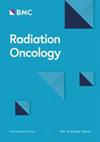光子、质子和碳离子放射疗法治疗颅内单发纤维瘤/血管瘤的疗效和毒性
IF 3.3
2区 医学
Q2 ONCOLOGY
引用次数: 0
摘要
中枢神经系统的孤立性纤维性肿瘤(SFT)非常罕见,治疗方案也不成熟。本研究旨在评估放疗(RT)和再放疗(re-RT)治疗新发颅内单发纤维瘤和复发颅内单发纤维瘤的临床疗效。这项回顾性研究分析了 2000 年至 2020 年间,海德堡大学医院对接受放疗(RT)治疗颅内 SFT 的患者("初诊组")进行的不同 RT 模式的疗效和毒性。我们进一步分析了该组群中肿瘤复发并在本院接受再次放疗的患者("再次放疗(re-RT)组")。初治组的中位随访时间为 54.0 个月(0-282),再照射组的中位随访时间为 20.5 个月(0-72)。RT方式包括三维适形RT(3D-CRT)、强度调制RT(IMRT)、立体定向放射外科(SRS)、质子RT和碳离子RT(C12-RT)。响应率根据 RECIST 1.1 标准进行分析。初治组包括 34 名患者(女:16;男:18),复治组包括 12 名患者(女:9;男:3)。初治组的总体反应率(ORR)为 38.3%(11 例),其中 32.4%(11 例)完全缓解(CR),5.9%(2 例)部分缓解(PR)。5.9%(2人)的患者病情稳定(SD),41.2%(14人)的患者病情进展(PD)。再RT组的CR和PR分别为25.0%和17.0%,PD为58.0%。初治组的1年、3年和5年无进展生存率分别为100%、96%和86%,再RT组分别为81%、14%和14%。与光子疗法(18 例)(OR = 0.038;P = 0.002)以及剂量≥ 60.0 Gy(15 例)与 < 60.0 Gy(14 例)(OR = 0.145;P = 0.027)相比,粒子照射(11 例)与原发性复发的可能性更低。女性的肿瘤复发风险高于男性(OR = 8.07; p = 0.014),男性的中位 PFS 为 136.3 个月,而女性为 66.2 个月。这些数据表明,RT是治疗颅内SFT的有效方法,具有较高的LPFS和PFS率。放射剂量≥60 Gy可降低肿瘤复发率。粒子疗法可能与原发性复发风险较低有关,这可能是由于应用较高RT剂量的可行性。本文章由计算机程序翻译,如有差异,请以英文原文为准。
Efficacy and toxicity of photon, proton, and carbon ion radiotherapy in the treatment of intracranial solitary fibrous tumor/hemangiopericytoma
Solitary fibrous tumors (SFT) of the central nervous system are rare and treatment options are not well established. The aim of this study was to evaluate the clinical outcomes of radiotherapy (RT) and re-radiotherapy (re-RT) for de novo intracranial SFT and recurrent intracranial SFT. This retrospective study analyzed efficacy and toxicity of different RT modalities in patients who received radiotherapy (RT) for intracranial SFT at Heidelberg University Hospital between 2000 and 2020 following initial surgery after de novo diagnosis (“primary group”). We further analyzed the patients of this cohort who suffered from tumor recurrence and received re-RT at our institution (“re-irradiation (re-RT) group”). Median follow-up period was 54.0 months (0–282) in the primary group and 20.5 months (0–72) in the re-RT group. RT modalities included 3D-conformal RT (3D-CRT), intensity-modulated RT (IMRT), stereotactic radiosurgery (SRS), proton RT, and carbon-ion RT (C12-RT). Response rates were analyzed according to RECIST 1.1 criteria. While the primary group consisted of 34 patients (f: 16; m:18), the re-RT group included 12 patients (f: 9; m: 3). Overall response rate (ORR) for the primary group was 38.3% (N = 11), with 32.4% (N = 11) complete remissions (CR) and 5.9% (N = 2) partial remissions (PR). Stable disease (SD) was confirmed in 5.9% (N = 2), while 41.2% (N = 14) experienced progressive disease (PD). 14% (N = 5) were lost to follow up. The re-RT group had 25.0% CR and 17.0% PR with 58.0% PD. The 1-, 3-, and 5-year progression-free survival rates were 100%, 96%, and 86%, respectively, in the primary group, and 81%, 14%, and 14%, respectively, in the re-RT group. Particle irradiation (N = 11) was associated with a lower likelihood of developing a recurrence in the primary setting than photon therapy (N = 18) (OR = 0.038; p = 0.002), as well as doses ≥ 60.0 Gy (N = 15) versus < 60.0 Gy (N = 14) (OR = 0.145; p = 0.027). Risk for tumor recurrence was higher for women than for men (OR = 8.07; p = 0.014) with men having a median PFS of 136.3 months, compared to women with 66.2 months. The data suggests RT as an effective treatment option for intracranial SFT, with high LPFS and PFS rates. Radiation doses ≥ 60 Gy could be associated with lower tumor recurrence. Particle therapy may be associated with a lower risk of recurrence in the primary setting, likely due to the feasibility of higher RT-dose application.
求助全文
通过发布文献求助,成功后即可免费获取论文全文。
去求助
来源期刊

Radiation Oncology
ONCOLOGY-RADIOLOGY, NUCLEAR MEDICINE & MEDICAL IMAGING
CiteScore
6.50
自引率
2.80%
发文量
181
审稿时长
3-6 weeks
期刊介绍:
Radiation Oncology encompasses all aspects of research that impacts on the treatment of cancer using radiation. It publishes findings in molecular and cellular radiation biology, radiation physics, radiation technology, and clinical oncology.
 求助内容:
求助内容: 应助结果提醒方式:
应助结果提醒方式:


